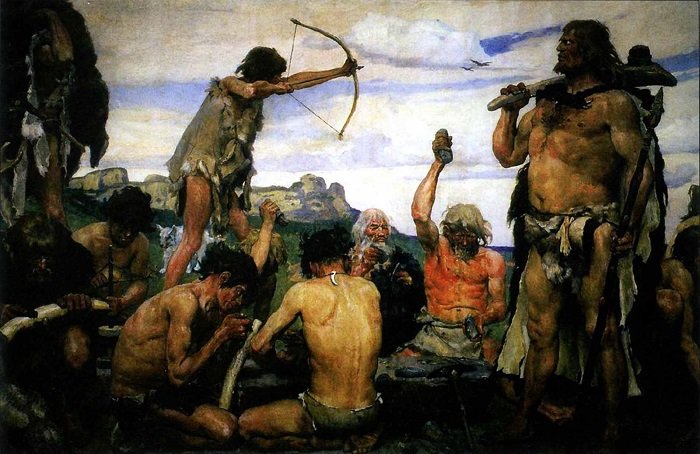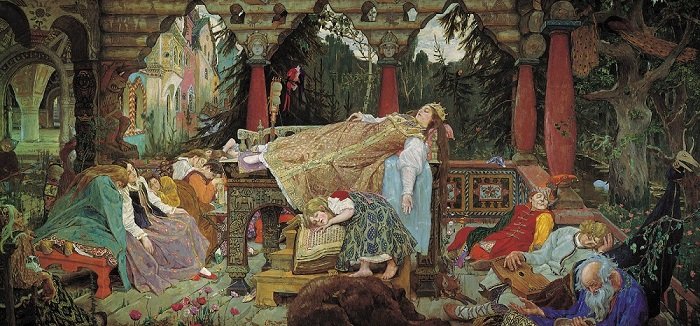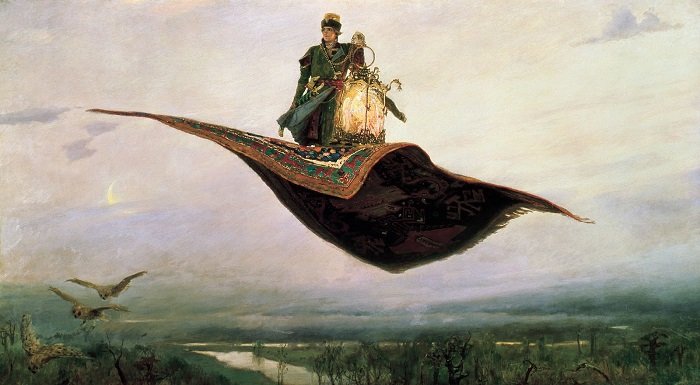Favourites on Friday - Viktor Vasnetsov, painter
The first painting I saw by the Russian painter, Viktor Vasnetsov, was ‘Tsarevich Ivan Riding the Grey Wolf’ way back in a book of Russian of fairy tales.
‘Tsarevich Ivan Riding the Grey Wolf’ (1889)
It took me many years to get around to finding out the name of the artist, and once I did, I started to look for more of his paintings.
And today, I’m going to indulge in his paintings, and share what I know of him – a very talented man, and prolific painter who fulfilled his dreams through his own hard work.
Viktor Vasnetsov, best known for his historical and mythological paintings, was born in May 1848 in the village of Lopyal, near Vyatka (now Kirov).
Destined to become a priest like his father and grandfather before him, he attended and graduated from a seminary before choosing to give up his theological career in favour of becoming a painter.
His father, a well-educated man, was interested in painting, among other things, and his grandfather was an icon painter, so Vasnetsov was no stranger to art.
Having decided to attend the Imperial Academy of the Arts in St. Petersburg, he auctioned two of his paintings to raise money for the journey.
He became a student at the Academy in 1868, where he studied until 1875, and gave private lessons, and illustrated for a number of publications to pay his way.
His first paintings, which included ‘Tea-Drinking in a Tavern’ were displayed in 1872-1874, and showed his ability to observe and recognise the minutiae of the life of the common people, because he himself knew and recognised life.
The painting, ‘Moving House’, for example, shows vividly the reality of life for poor, old people, homeless and unwanted.
‘Tea Drinking in a Tavern’ (1874)
‘Moving House’ (1876)
For a couple of years, from 1876 to 1878, encouraged by his friends, Vasnetsov moved to and lived in Paris. Although most of his work in the city was from nature, he also concentrated on workers and peasants.
After returning to Russia, in 1878, he and his family moved to Moscow; he wrote, ‘When I arrived in Moscow, I felt I had arrived home and need travel no further; the Kremlin and Saint Basil’s brought tears to my eyes, so dear to my soul, so unforgettable were they.’
It was here that he turned to the subjects he is perhaps best known for – Russian fairy tales, and history.
It was probably inevitable that this would happen… the countryside where he grew up was one of forest and valleys, with meandering streams; he’d grown up hearing fairy tales and stories of Russian heroes, or ‘bogatyrs’…
To quote Vasnetsov:
‘I have always been convinced that both genre and historical pictures, and fairy-tales, songs, folk epics and dramas, all reflect the whole inner and outer make-up of a nation, with its past and present, and perhaps even its future … It is a poor nation that does not remember, value and love its history.’
Vasnetsov’s first historical painting was ‘After the Battle of Igor Svyatoslavich with the Polovtsi’ (1880).
Prince Igor Svyatoslavich the Brave was a 12th century Rus prince who, throughout his life, only ever suffered one defeat, which became immortalized in ‘The Lay of Igor’s Campaign’, the most celebrated epic of Rus.
Vasnetsov’s preliminary sketches show that he began by depicting the fury of battle, which is what most battle paintings portray, but he gradually changed his approach to show the tragedy instead; the fallen warriors are shown lying as though asleep. Unfortunately, the painting did not win general recognition.
‘After Igor Svyatoslavich's Fighting with the Polovtsy’ (1880)
What did gain him recognition as a highly talented artist was the 82foot long frieze – ‘The Stone Age’ – that took him about 2 years to complete.
He did his research by studying historical documents and talking to archaeologists to gain as good an insight as he could into Stone Age life before tackling the monumental task.
Part of ‘The Stone Age’ frieze
This led to an invitation in 1885, the year he finished the frieze, to help decorate the newly-built St Vladimir’s Cathedral in Kiev.
Deciding that the murals would be a monument to ancient Rus, Vasnetsov would not relent even when church officials demanded he paint in the official, traditional style.
And so, the faces of the saints on the walls of the cathedral are not stylised ones, but those of the Russian people.
Russian bishops on the wall of St Vladimir’s Cathedral
Even while working on the cathedral, Vasnetsov continued to produce other paintings, like ‘Tsarevich Ivan Riding the Grey Wolf’ (1889), based on the Russian fairy tale, ‘Tsarevich Ivan, the Fire Bird and the Grey Wolf’.
In 1891, Vasnetsov returned to Moscow with his family where he finally built his own studio.
Here, he began work on the painting, ‘Bogatyrs’ (similar to a ‘knight-errant’); in 1898, he presented this painting, which had been a work-in-progress for about 20 years.
It depicts 3 favourite heroes of the byliny or ancient epic folk stories, Ilya Muromets, Dobrynya Nikitich and Alyosha Popovich.
‘Bogatyrs’ (1898)
At the turn of the century, Vasnetsov did not slow his pace, working simultaneously on several pictures, including ‘Boyan’ (1910) – this was the name of a bard mentioned in ‘The Lay of Igor’s Campaign’; ‘The Sleeping Princess’; and ‘The Unsmiling Tsarevna', based on the fairy tale of the same name.
‘Boyan’ (1910)
‘The Sleeping Princess’
‘The Unsmiling Tsarevna’ (1916-1926)
Who knows how many more paintings this talented man would have produced… he was still painting when he died in his studio in Moscow, in July 1926, aged 78.
‘A Knight at the Crossroads’ (1878)
'Three Tsarevnas of the Underground Kingdom' (1879)
'The Flying Carpet' (1880)
'Battle between the Scythians and the Slavs' (1881)
'Ivan the Terrible' (1897)
'Ilya Muromets' (1914)
















